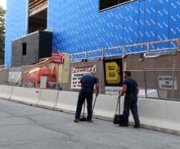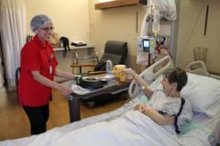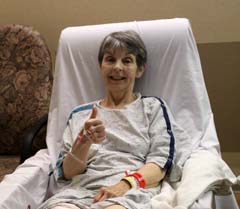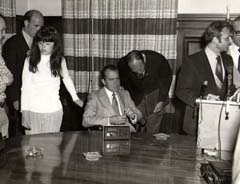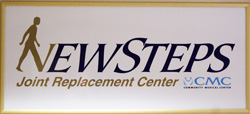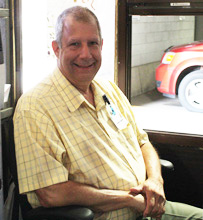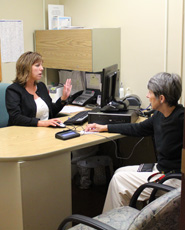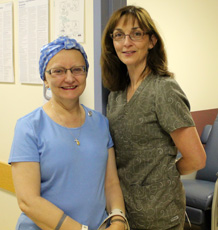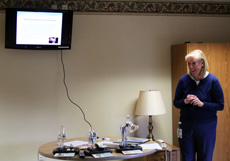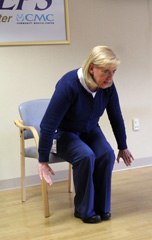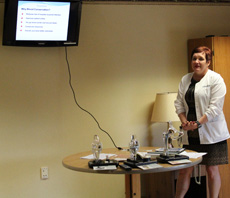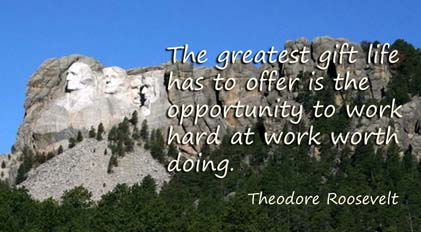America at Its Best: Memorable Moments from Kitch’s Total Knee Replacement Surgery, Part 1.
Written by Tony Mussari, Sr.
Edited by Kitch Loftus-Mussari
Digital photographs by Tony Mussari, Sr.
Copyright 2014
Mussari-Loftus Associates
The Face of America Project
A gentle word, a kind look, a good-natured smile can work wonders and accomplish miracles. William Hazlitt
Lasting Impressions
William Hazlitt’s 15 words got me thinking about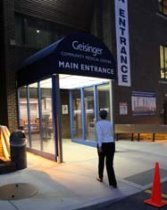 several people who helped us during Kitch’s total knee replacement surgery at Geisinger-CMC in Scranton. Hazlitt’s beautiful words were written a long time ago, but they have value to every patient and caregiver who face the reality of serious surgery. When anxiety levels are high, the actions and words of the people you meet leave lasting impressions on the heart and soul.
several people who helped us during Kitch’s total knee replacement surgery at Geisinger-CMC in Scranton. Hazlitt’s beautiful words were written a long time ago, but they have value to every patient and caregiver who face the reality of serious surgery. When anxiety levels are high, the actions and words of the people you meet leave lasting impressions on the heart and soul.
This is an attempt to chronicle our experience and thank the people who went out of their way to calm our fears with a gentle word, a kind look and a good-natured smile.
Arrival
We arrived at the hospital shortly at 5:45 a.m. We were anxious. The both of us have had serious surgery, and we know the rules of the road as it were. Despite the early hour, we were greeted in a friendly way in admissions. After the traditional forms were signed, and Kitch received her wrist band, we took the elevator to the fifth floor.
It was 5:57 a.m. when Kitch received her room assignment and the items she would wear for surgery.
At 6:21 a.m., a pleasant nurse helped Kitch with a number of things including additional wrist bands that clearly identified cautions and vulnerabilities.
At 6:49 a.m., nurse Betsy Guinan, the Nurse Navigator for 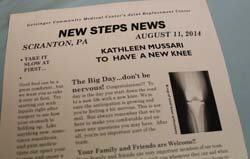 New Steps Joint Replacement Center, walked into our room. She presented Kitch with a personalized edition of NEW STEPS NEWS. The headline summarized the story, KATHLEEN MUSSARI TO HAVE A NEW KNEE. The lead story offered this advice, The Big Day…don’t be nervous!
New Steps Joint Replacement Center, walked into our room. She presented Kitch with a personalized edition of NEW STEPS NEWS. The headline summarized the story, KATHLEEN MUSSARI TO HAVE A NEW KNEE. The lead story offered this advice, The Big Day…don’t be nervous!
This gesture brought a smile to Kitch’s face, and it helped the both of us relax. We felt very comfortable with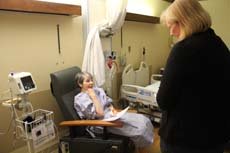 Betsy because we had a connection with her from what we affectionately call the “knee school.” Three weeks earlier, Betsy conducted a comprehensive introduction to the surgery, and its aftermath. During that session, Betsy shared valuable information about every aspect of knee replacement surgery.
Betsy because we had a connection with her from what we affectionately call the “knee school.” Three weeks earlier, Betsy conducted a comprehensive introduction to the surgery, and its aftermath. During that session, Betsy shared valuable information about every aspect of knee replacement surgery.
Equally important, she created a sense of community and belonging for the patient and the caregiver. She made everyone in the room feel a sense of connection with her and the other members of Dr. Harry Schmaltz’s team. We weren’t numbers. We were people with a medical problem they intended to address with the best medical and therapeutic techniques available.
On this morning of apprehension, Betsy’s kind way and her engaging smile made our reunion with her very special. She calmed our fears and she lifted our spirits at a time when we needed encouragement. When she left the room, Kitch was ready to take the next step on her journey.
Waiting and Hoping
At 7:06 a.m., Kitch was taken to the second floor of the hospital 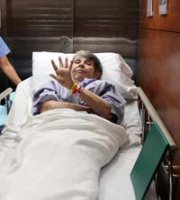 where she would be prepped for the operation. That involved conversations with her surgeon Dr. Harry Schmaltz, the anesthesiologist, the nurse anesthetist, and an unexpected, pleasant meeting with a nurse, Eileen who had a home town connection with Kitch. Their conversation about graduates from Dunmore High School helped Kitch to think about something other than the operation.
where she would be prepped for the operation. That involved conversations with her surgeon Dr. Harry Schmaltz, the anesthesiologist, the nurse anesthetist, and an unexpected, pleasant meeting with a nurse, Eileen who had a home town connection with Kitch. Their conversation about graduates from Dunmore High School helped Kitch to think about something other than the operation.
While Kitch was in surgery, I tried to pass the time in productive ways. To be honest, it wasn’t easy.
At sometime after 8 a.m., I went outside for a walk. Much to my surprise, I watched a crew of workers with brooms and dustpans cleaning both sides of the street in front of the hospital. I was impressed by the way they did their job.
I had a chance meeting with an old friend whose wife was having partial knee replacement surgery. We talked about our childhood experiences in a neighborhood barber shop where he learned to read, and I learned the power of community.
When I returned to the fifth floor, I watched a woman with a duster clean every nook and cranny of the hallway. She was determined to do her part to maintain a high standard of cleanliness.
As I watched Karen work, I thought to myself how important this work is, and how conscientiously she is attending to it.
When the operation was finished, I was called to the nurse’s station to answer a telephone call from Dr. Schmaltz. His words were reassuring:
“The operation went well. There were no complications. All of her vital signs are positive. She is in the recovery room, and she is doing well.”
Without question, that was the best news of the day.
Together Again
It was 12:01 p.m., when the elevator door opened, and Kitch was brought back to the New Steps section of the fifth floor.
At 12:15 a delightful woman, Danielle Mazzoni, a nurse assistant, was attending to the things that would make Kitch comfortable. Danielle has been doing this kind of work for 17 years.
attending to the things that would make Kitch comfortable. Danielle has been doing this kind of work for 17 years.
Two words best describe Danielle’s care, competent and compassionate. One word describes her demeanor, charming.
About an hour later, the door opened and a young woman with a beautiful smile entered the room with Kitch’s lunch. Mahadevi works in nutritional services. The words at the bottom of her identification card read “Make it the best.” She did exactly that with her courteous and cooperative manner and a smile that was just what the doctor ordered for a recovering patient and an anxious caregiver.
At 1:32 p.m. we received a visit from a respiratory therapist named Karen. She has been doing this kind of work for 35 years. She told us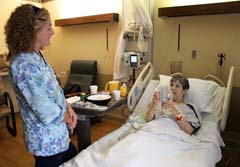 she loves her job, and it shows.
she loves her job, and it shows.
Karen is on a mission to protect patients from hospital acquired pneumonia. Standing at the foot of Kitch’s bed, she carefully explained how that is accomplished. It’s not all that easy to do the appropriate exercises 10 times every hour, but Karen inspires her patients to make the effort.
Kitch respected the information Karen shared, and she honored her suggestion to do the breathing exercise.
For most of the afternoon, Kitch rested. She obliged the visits she received from nurses and therapists who monitored her progress and checked a number of devices that guaranteed a successful outcome.
At one point, she slowly took her first steps with the help of a physical therapist. She also had her first cup of coffee, and she talked with her cousin on the telephone.
At 2:37 p.m., she had a priceless moment with a Chaitali 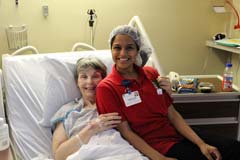 Patel a member of the food services team. When Chaitali walked into the room to discuss the dinner menu with Kitch, her beautiful smile evoked a wonderful response from Kitch:
Patel a member of the food services team. When Chaitali walked into the room to discuss the dinner menu with Kitch, her beautiful smile evoked a wonderful response from Kitch:
“You are a delightful young lady.”
The picture of Chaittali and Kitch is classic proof of the wisdom of William Hazlitt’s
words.
When I left the hospital at 8 p.m., I knew that Kitch was in good hands.
Day one was a great success thanks in no small part to the incredibly successful process created by Dr. Harry Schmaltz and executed by members of his New Steps team and the Geisinger-CMC team. Yes, the medical science was right. Yes, the competence of the medical care Kitch received after the operation was right. There was, however, one differential in her care. It can best be described with an adaptation of the words of William Hazlitt:
The gentle words we heard lifted our spirits. The kind looks we received gave us a feeling of community and belonging, and the good natured smiles worked wonders for both the patient and her caregiver.
Thank you, Betsy.
Thank you, Eileen.
Thank You, Karen.
Thank You, Danielle.
Thank You, Mahadevi.
Thank You, Karen.
Thank You, Chaitali.
Thank you, Dr. Schmaltz, and a special thank you to the nurses and therapists who took care of Kitch throughout the day and during the long hours of her first night in the hospital.
Please provide feedback to:
tony.mussari@gmail.com
